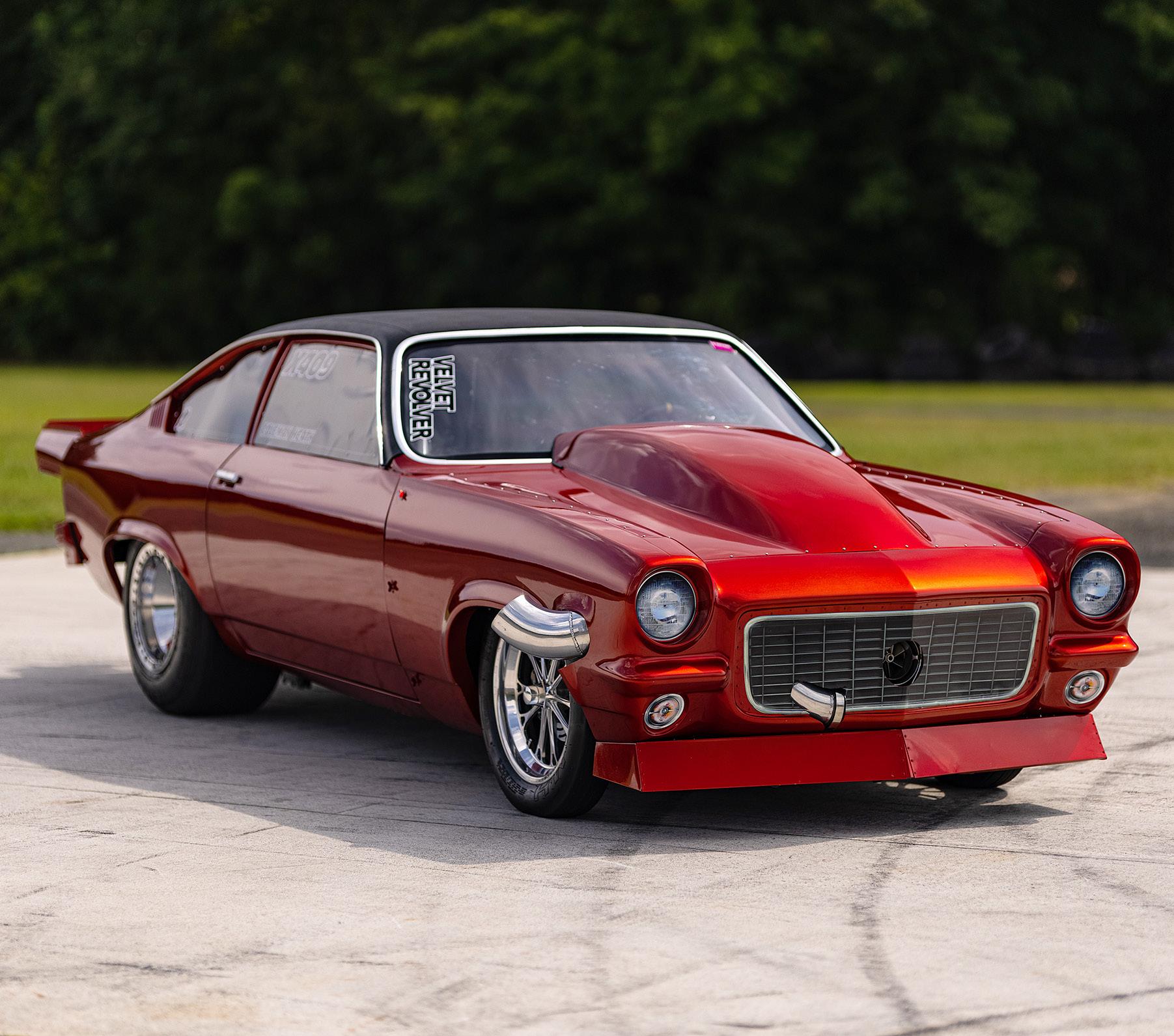


The streets and strips of the country are filled with countless numbers of hardcore builds, with a few body styles that obviously dominate the mix and yet others that are rarely seen, such as the Chevrolet Vega. Once a very popular candidate for street and strip builds, mostly due to size and weight, the Vega has now all but vanished, aside from a few resourceful diehard enthusiasts like Coleman Heath.
The Vega is a subcompact car from General Motors built from 1970 to 1977, and it had a short production run for many reasons. The Vega became widely known as Chevy’s most poorly designed vehicle on the road; issues ranged from drivetrain failures to premature rust and significant safety problems, but that didn’t stop horsepower junkies from taking advantage of what the Vega did have going for it.

Like many gearheads, Coleman grew up following in his father’s footsteps with an



nity. His dad restored cars and then set them up for road racing; Coleman started racing on his own at the tender age of 12. After much success, heading into his late teens and twenties, he began restoring some of his own cars and started getting the itch to drive straight. He fell in love with small tire racing at Kinston Drag Strip, which is his hometown track. After building a Chevelle and Cama-


ro, he sought out to do something different for his all-out small tire radial car build and found this 1971 Vega. It had already been retired from racing once, but not the level Coleman wanted to push the car towards. A complete build from top to bottom needed to happen. “This car was originally built to race somewhere around 1989. I’m assuming this by time tickets found from Englishtown






 A touch of class is added to the mix via a black vinyl roof
A touch of class is added to the mix via a black vinyl roof
NJ,” Heath explained. “It looks like it ran NHRA Super Gas or a class comparable. I bought the car from a great friend of mine (Todd Jackson) as a rolling chassis and completely disassembled it to build it as a small tire radial car.”


Like we said, the Vega is small; meaning that some serious chassis and suspension work is needed to become competitive. Small means light and nimble but also short and narrow which can cause handling issues with the type of power Heath was looking at, so he had Chris Herring of HRT complete all of the chassis work. First, considering how


This Vega just looks badass from any angle. Up front a Glasstek front end was mated flawlessly to the surrounding factory panels and a right side bullhorn exhaust dumps spent gases, while a single ’chute out back helps with stopping duties at over 170 MPH in the 1/8th!







the short wheelbase car will react going down the track at the speeds Coleman wanted to push it too, they completed a 25.5 certified cage. Next, Chris cut the front end off and fabricated a new structure around a motor plate system. The front Suspension consists of Applied Racing Technology a-arms and Strange Engineering struts. Finally, Coleman put a Tin Soldiers Racecars four-link rear suspension setup to good use and coupled it with Menscer Motorsports shocks.

The LSX power Coleman would be using is not new to the racing world by any means, and Andrew Arnette of P&M Performance used a Dart LS NEXT block as the base to prepare a race-winning engine for him. Boost-specific JE pistons are pinned to Callies rods, and the combo rotates around a Callies Ultra Billet crank. Dart Pro1 LS3 heads provide copious amounts of flow and are fitted with Manley severe-duty valves, springs, and PRC rockers. Additional air induction is forced through a Garrett 102mm turbo. A Holley Performance Hi-Ram intake ingests compressed air and directs it into the LSX, and Coleman built the supporting turbo piping with the help of his best friend, Quintin. For fueling, oversized is the way to go in this arena. The turbocharged bullet uses an Enderle belt drive








Inside is clean and simple with zero factory equipment left in the mix. Instead, a 25.5 SFI Certified cage protects Heath and a fair share of carbon adds cool factor while he’s laying the smack down on the guy in the other lane!






pump that supplies M1 racing fuel to Billet Atomizer 700pph injectors. Coleman tunes the Vega himself using a Holley Dominator stand-alone ECU, and he estimates it puts down in the neighborhood of 2000whp on a clean A to B pass.


The rest of the drivetrain is just as stout as the motor package and includes a Camerons Torque Convertor Service two-speed TH400 and converter. Coleman continued his “tough as nails” theme and went with a near indestructible 9-inch from Moser
A Holley digital dash relays vitals to the driver and the 2-speed TH400 is air-shifted by a Hurst pistol grip shifter. All electronics are fully accessible on the passenger side kick panel.


Engineering, complete with their 40 spline gun-drilled axles, spool, and 3.90 gear set. Strange Engineering front and rear brakes bring the Vega to a halt and the compact Chevy rides on Weld Racing V-series front runners with M&H tires. The rears are a little different than the typical combination, using a 15x13 bead-locked Sanders wheel with a stretched 275/60/15 Mickey Thompson radial to allow a larger contact patch of rubber on the track surface.
The interior is strictly business, but

with some added style in the form of carbon tubs, dash panel, and race seat. The Holley EFI dash display allows all vitals to be kept in check and a Hurst pistol grip shifter is ready for that high gear shift. Electronics are easily accessible on the passenger side kick panel, and fire suppression activation is located directly to the driver’s right. If you’ve seen a Vega in person, then you understand they need some “sprucing up” in the exterior department – they were, after all, meant to be an early, somewhat dull compact/






Coleman Heath’s 1971 Chevrolet Vega No-Time Drag Car
Body & Paint:
SIMS Candy Apple Red Paint. Painted By Mike Taylor TNT Customs.

Chassis & Suspension Modifications:

Rear Four link kit from Tin Soldiers Racecars. Shocks are Menscer Motorsports. Brakes are from Strange Engineering. All Chassis Work was done by owner and Chris Herring at HRT in Kinston NC.
Engine: Engine is based on a DART LS NEXT block and was built by Andrew Arnette at P&M Performance in Jacksonville NC. Rotating assembly consists of a Callies Ultra Billet crank, Callies rods and JE pistons.

Cylinder Heads: Dart Pro 1 LS3 heads PRC rockers, Manley Severe Duty valves.

Induction & Fuel Delivery: Holley Hi-Ram intake, Enderle pump, M1 fuel
Electronics: Holley Dominator system tuned by owner.
Power Adder: Single Garret 102mm Billet wheel turbo.
Transmission: 2 speed TH400 and convertor built by Camerons Torque Convertor Services in SC.
Rear: Moser Fab 9 with 3.90 gear set and a Moser spool. 40 spline gun-drilled Moser axles.
Tires & Wheels:
Front wheels are Weld V series with M&H front runners. Rear wheels are Sanders 15x13 and Mickey Thompson 275 60 15 Radial Pros.
Interior: Holley digital dash, TRZ steering wheel, Hurst shifter and seat custom carbon seat.
ET & MP: Low 4 sec range at 170+ MPH (No time Car)
Thanks To: Jesse Heath, Jordan Alphin and Quintin Perry for helping build the car along the way. Josh Deaver for talking me into building it, and my closest supporters Nicky (my wife) and daughter Annleigh.


Coleman Heath’s No Time 1971 Chevy Vega...don’t blink!




economy car, and anything but a race car. Mike Taylor of TNT Customs was brought onboard to turn this mundane ride into the “Velvet Revolver”. Before laying any paint, Mike fit a new fiberglass front clip from Glasstek onto the car and worked with the remaining factory original panels then added a Carls Aluminum Works wing to give the Vega a finishing touch. The paint color is what sets this Vega apart from most others, that is, if you happen to see another one. TNT used SIMS Candy Apply Red to create that slick skin, and it looks sharp, especially in the sunlight.
Coleman and his friends Quintin, Jesse, and Jordan spent less than six months on this project, very impressive considering the complexity and uniqueness of the parts. His main motivation behind choosing the Vega was the fact that chances are you won’t see another one like it on race day, and so far that has been the case; “Its light, and it ain’t no Fox Body. I like to be different,” Heath added with a smile.
Even with the short wheelbase, Coleman has enough seat time in drag racing to make clean 8th-mile passes at 170+mph, and, like all racers, he loves winning! But since this is a no-time grudge car we can only tell you that it runs in the low 4-second 1/8-mile range, and that it has definitely hurt some feelings! So the next time you line up beside the Velvet Revolver, rest assured it will be cocked, locked and ready to rock!





